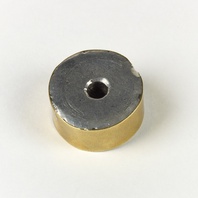
Viking Objects
Reproduction Copper Alloy-Edged Lead Weight
A lead weight edged with a copper alloy band.
Read More
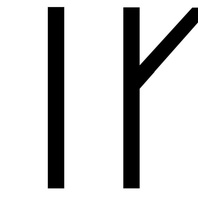
Viking Names
Bekki
The Old Norse postulated male name Bekki is possibly an Anglo-Scandinavian formation originally from Old Norse bekkr ‘brook’. However, it could also be related to Frisian Becke or Continental Germanic Becco. Another possible derivation is from Old English becca ‘mattock’. Bekki is believed to be the first element in the place-name Bigby, Lincolnshire.
Read More
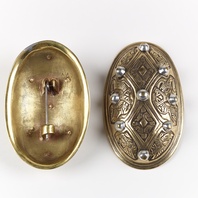
Viking Objects
Reproduction Oval Brooches
Oval brooches were used to fasten dresses in the Viking Age. They are diagnostically Scandinavian and indicate a Scandinavian identity wherever they are found. This pair of brooches is a reproduction of a pair found at Adwick le Street near Doncaster. The mismatched pair were buried with a Norwegian woman who died within a generation of the arrival of the Great Army in the mid-ninth century. Scandinavian brooches came in a variety of sizes and shapes which included disc, trefoil, lozenge, equal-armed, and oval shapes. The different brooch types served a variety of functions in Scandinavian female dress with oval brooches typically being used as shoulder clasps for apron-type dresses and the rest being used to secure an outer garment to an inner shift. Anglo-Saxon brooches do not match this diversity of form with large disc brooches being typical of ninth century dress styles with smaller ones becoming more popular in the later ninth and tenth centuries. However, since disc brooches were used by both Anglo-Saxon and Scandinavian women they are distinguished by their morphology. Scandinavian brooches were typically domed with a hollow back while Anglo-Saxon brooches were usually flat. Moreover, Anglo-Saxon brooches were worn singly without accompanying accessories.
Read More
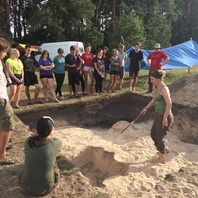
Blog Post
Vypovziv: A Viking Age outpost in Ukraine
In July 2018 a group of University of Nottingham students from the School of English went on an archaeological expedition to Vypovziv, Ukraine. The group was led by Dr Cat Jarman from the University of Bristol whose work on Viking camps at Repton has yielded spectacular results. As a result, Dr Jarman’s work with the Repton winter camp is particularly relevant to the project and allows sites such as Vypovziv to be compared more easily with its English counterparts. (c) William Pidzamecky The village of Vypovziv is located two hours north of Chernihiv and is the site of a Viking Age Rus outpost. The outpost served as a control point along the Desna river route as well as a toll/re-supply station for travellers and merchants coming along the river to or from Kyiv during the later 9th through to the late 10th century. The Viking outpost is located on top of a tall ridge that stands out in the low marshy landscape and would have bisected the Desna River. The site included a fortified area with a palisade and a surrounding open settlement. The site included a fortified area with a palisade and a surrounding open settlement. Vypovziv, and sites like it, shares many similarities such as layout, location, and types of artefacts to winter camps in England such as Torksey and Repton, where Dr Cat Jarman is currently conducting archaeological fieldwork. Vypovziv, Repton, and Torksey all had some form of defence to protect them, were located in naturally strategic positions near rivers which provided easy access by boat, and at one stage in their lifespan became administrative and/or commercial centres. All three sites had a mixture of inhabitants, including women and children, and were specifically created by Scandinavian immigrants. The main difference between them is the initial motivation for their founding, Vypovziv was established as a point of control along a trade route while sites such as Repton and Torksey began life as a base for the Great Viking Army invading England. The Nottingham team were given a previously unexcavated section within the boundaries of what would have been the settlement area of the outpost just down the ridge from the fortified area. The artefacts found ranged in date from the late 9th century to the 12th century and included tools such as needles and awls, imported and local glass beads, imported jewellery, and various pieces of pottery, one making its way from the Byzantine Empire. The last day produced perhaps the most interesting finds, two ovens demarcating two separate dwellings. The team looks forward to returning next July to continue their exciting work. The expedition was made possible by funding secured by William Pidzamecky through the Cascade Grants Programme. The group joined the archaeological team from the University of Chernihiv, led by Dr Vyacheslav Skorohod, which has been excavating at the site for over a decade.
Read More
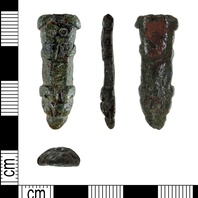
Viking Objects
Copper-Alloy Strap-End (DENO-E40172)
An incomplete copper-alloy strap-end decorated with zoomorphic motifs and stylised human or animal head. It has been identified typologically as belonging to Thomas Class B Type 4.
Read More
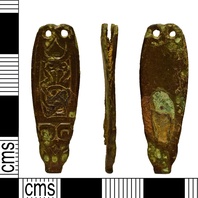
Viking Objects
Copper-Alloy Strap-End (NARC-033287)
An incomplete copper-alloy strap-end classified as Thomas’ Class A, Type 1, with zoomorphic terminal and Trewhiddle-style decoration. The decoration is composed of an incised pattern which depicts two semi-circular ears below which are two triangular eyes to either side of the head can be see, flanked by a forked central brow. The central panel bears Trewhiddle-style decoration depicting a beast with serpentine curvilinear tail.
Read More
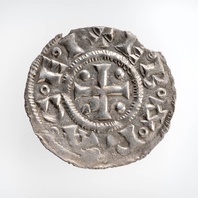
Viking Objects
Northumbrian Viking Penny (CM.952-2000)
This Sword St. Peter type silver penny is not associated with any particular ruler but was minted in the Viking kingdom of Northumbria. The coin features a sword image which is usually considered to represent the sword of St Peter, whose name features on the same side of the coin, and a hammer which is often taken to be Thor’s hammer, thus mixing the iconography of the Christian and Norse religions. It was found as part of the Thurcaston hoard which was probably buried c.923-925 CE, approximately five years after Leicester had been retaken by Mercia (c.918). The coins in the hoard are Anglo-Saxon, Arabic and Danelaw issues, showing the wide-ranging contacts between societies at this time. After the establishment of the Danelaw, some Viking leaders decided to mint their own coins to solidify their legitimacy in the eyes of the local populace. This created a hybrid economy where some members of the Danelaw used bullion and others used coins. The bullion economy resulted in some coins being cut into pieces to pay for items.
Read More
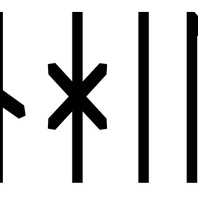
Viking Names
Gunnhild
Gunnhildr is a very common female name throughout the Viking world. In England, the name has a particularly wide geographical distribution that extends beyond the Danelaw and beyond the Viking Age. Its popularity was most likely influenced by its use in the Danish royal family in the eleventh century, when it was borne by an aunt, a daughter and a niece of King Cnut. The name is also the first element of the place-name Gunthorpe, Nottinghamshire.
Read More
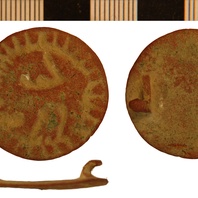
Viking Objects
Brooch with Backwards-Facing Beast (NLM-08BAEB)
It has been suggested that the beast motif on this brooch represents a horse, but identification is uncertain. This brooch was probably the property of an ordinary person rather than of a member of the social elite. It is of a fairly common type. For more information on Scandinavian jewellery in England check out our blog: Brooches, Pendants and Pins: Scandinavian Dress Accessories in England.
